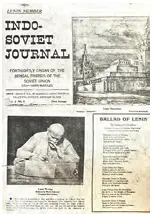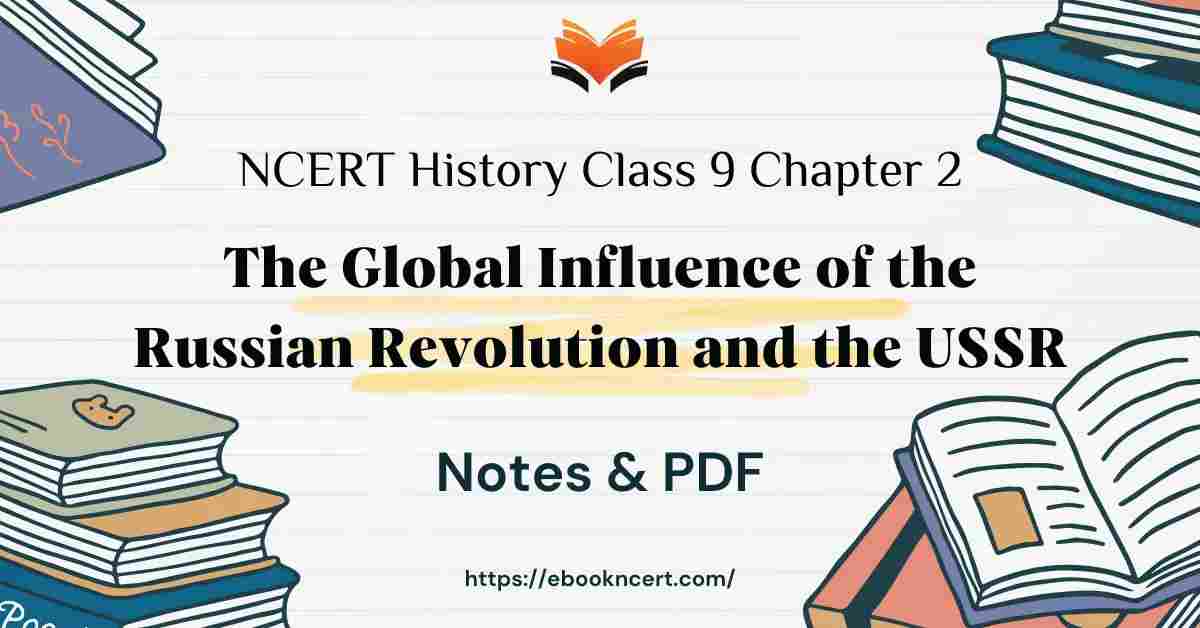The Global Influence of the Russian Revolution and the USSR – Concept & Notes PDF
Topic & sub-topics covered: The Global Influence of the Russian Revolution and the USSR and MCQs Questions: Socialism in Europe and the Russian Revolution (All single detail notes are exam-oriented).
We have discussed in-depth and exam-oriented pointers that can be asked in the board exam of class 9th about the “The Global Influence of the Russian Revolution and the USSR” from the NCERT History notes for class 9th chapter 2nd “Socialism in Europe and the Russian Revolution“.
Download the NCERT History for Class 9th Chapter 2 Socialism in Europe and the Russian Revolution Notes PDF
Looking for clear, concise NCERT notes on Chapter 2: Socialism in Europe and the Russian Revolution? Download the NCERT History Class 9 Chapter 2 Notes PDF and make your revision easier. These notes break down key events, important terms, and timeline-based developments – from the rise of socialism in Europe to how the Russian Revolution changed global politics. Perfect for quick revision before exams, class tests, or just to understand the chapter better. Click to download the free PDF now and study smarter.
The Global Influence of the Russian Revolution and the USSR

- Many socialist parties in Europe did not fully approve of the Bolsheviks’ way of seizing and holding power.
- The idea of a workers’ state inspired people worldwide.
- Communist parties were formed in many countries, such as the Communist Party of Great Britain.
- The Bolsheviks encouraged colonial nations to follow their example.
- Non-Russians from outside the USSR participated in the Conference of the Peoples of the East (1920).
- Bolsheviks founded the Comintern – an international union of pro-Bolshevik socialist parties.
- Some foreign participants received education at the Communist University of the Workers of the East in the USSR.
- By the outbreak of the Second World War, the USSR had given socialism a global identity and stature.
- By the 1950s, it was recognized within the USSR that its style of government did not match the ideals of the Russian Revolution.
- The world socialist movement also acknowledged problems within the Soviet Union.
- The USSR transformed from a backward country into a great power with developed industries and agriculture.
- The poor were provided food, but essential freedoms were denied to citizens.
- Developmental projects were carried out through repressive policies.
- By the late 20th century, the USSR’s reputation as a socialist country had declined internationally.
- Socialist ideals still held respect among Soviet citizens despite the decline.
- In different countries, socialism was rethought and interpreted in varied ways.
Box 5: Writing about the Russian Revolution in India
- The Russian Revolution inspired many Indians.
- Several Indians attended the Communist University.
- By the mid-1920s, the Communist Party of India was formed.
- Indian communists maintained contact with the Soviet Communist Party.
- Prominent Indian leaders like Jawaharlal Nehru and Rabindranath Tagore visited Russia and wrote about Soviet Socialism.
- Indian writings gave impressions of Soviet Russia.
- In Hindi literature:
a. R.S. Avasthi wrote Russian Revolution, Lenin, His Life and His Thoughts (1920–21) and later The Red Revolution.
b. S.D. Vidyalankar wrote The Rebirth of Russia and The Soviet State of Russia. - Soviet Russia was written about in Bengali, Marathi, Malayalam, Tamil, and Telugu as well.
Source F: An Indian arrives in Soviet Russia in 1920
- Observation by Shaukat Usmani: First-time experience of Europeans mixing freely with Asians in Russia.
- Perception of Equality: Russians mingled freely with all people, creating the impression of a land of true equality.
- True Freedom Experienced: Witnessed freedom in its genuine form.
- Poverty Situation: People were poor due to counter-revolutionaries and imperialists.
- Public Morale: Despite poverty, Russians were more jovial and satisfied than before.
- Impact of the Revolution: Instilled confidence and fearlessness among people.
- Unity in Diversity: Real brotherhood was visible among people from fifty different nationalities.
- No Social Barriers: Absence of caste or religious barriers in social interaction.
- Rise of Public Expression: Every person became a confident speaker.
- Workers, Peasants, and Soldiers as Orators: Ordinary citizens spoke like professional lecturers.
Source G: Rabindranath Tagore wrote from Russia in 1930
- Moscow looked less clean compared to other European capitals.
- People in the streets did not appear smart or fashionable.
- The city was owned and run by the workers.
- The masses were no longer overshadowed by the upper-class “gentlemen.”
- Those who had lived in the background for ages had now come forward openly.
- The transformation reminded the author of the peasants and workers in India.
- The change in Russia seemed magical, like stories from Arabian Nights.
- Just a decade earlier, Russians were as illiterate, helpless, and hungry as Indian masses.
- In a few years, they had overcome ignorance and helplessness.
- The progress in Russia astonished the author, coming from a colonial Indian background.
New words:
- Deported – Forcibly removed from one’s own country.
- Exiled – Forced to live away from one’s own country.
Next & Previous Topics of NCERT/CBSE History Class 9 Chapter 2: Socialism in Europe and the Russian Revolution
| Topics No. | Topics Name |
|---|---|
| 1 | The Age of Social Change |
| 2 | The Russian Revolution |
| 3 | The February Revolution in Petrograd |
| 4 | What Changed After October? |
| 5 | The Global Influence of the Russian Revolution and the USSR |
MCQs on NCERT History Class 9 Chapter 2 Topic – The Global Influence of the Russian Revolution and the USSR
Here are the top exam-oriented MCQ-type questions on “The Global Influence of the Russian Revolution and the USSR” that you should prepare for your CBSE or state board exams:
Question 1. Which socialist party in Britain was influenced by the Russian Revolution?
a) Labour Party
b) Communist Party of Great Britain
c) Socialist Workers Party
d) Social Democratic Party
Answer: b) Communist Party of Great Britain
Question 2. What was the purpose of the Conference of the Peoples of the East (1920)?
a) To promote trade between Russia and Asia
b) To encourage colonial peoples to follow the Bolshevik experiment
c) To discuss European unity
d) To form a military alliance against imperialism
Answer: b) To encourage colonial peoples to follow the Bolshevik experiment
Question 3. What was Comintern?
a) A union of capitalist countries
b) An international union of pro-Bolshevik socialist parties
c) A Russian industrial council
d) A Soviet military organisation
Answer: b) An international union of pro-Bolshevik socialist parties
Question 4. Where did some non-Russians receive education under Bolshevik guidance?
a) Leningrad Political Academy
b) Communist University of the Workers of the East
c) Moscow International College
d) Lenin School of Social Sciences
Answer: b) Communist University of the Workers of the East
Question 5. By the outbreak of the Second World War, what had the USSR achieved?
a) Global dominance in capitalism
b) Socialism with global face and stature
c) Economic decline
d) Disintegration of the socialist movement
Answer: b) Socialism with global face and stature
Question 6. Which decade saw the USSR acknowledge internally that its governance did not match the ideals of the Russian Revolution?
a) 1920s
b) 1930s
c) 1940s
d) 1950s
Answer: d) 1950s
Question 7. What was one major achievement of the USSR despite repression?
a) Becoming a great power from a backward country
b) Expansion of colonial territories
c) Privatisation of industries
d) Abolition of socialism
Answer: a) Becoming a great power from a backward country
Question 8. In which year was the Communist Party formed in India?
a) Early 1910s
b) Mid-1920s
c) 1930s
d) 1940s
Answer: b) Mid-1920s
Question 9. Which Indian leaders visited the Soviet Union and wrote about socialism?
a) Jawaharlal Nehru and Mahatma Gandhi
b) Jawaharlal Nehru and Rabindranath Tagore
c) Rabindranath Tagore and Subhas Chandra Bose
d) Mahatma Gandhi and Bal Gangadhar Tilak
Answer: b) Jawaharlal Nehru and Rabindranath Tagore
Question 10.Who wrote “Russian Revolution, Lenin, His Life and His Thoughts”?
a) S.D. Vidyalankar
b) R.S. Avasthi
c) Rabindranath Tagore
d) Shaukat Usmani
Answer: b)R.S. Avasthi
Question 11. Which book was authored by S.D. Vidyalankar?
a) The Red Revolution
b) The Rebirth of Russia
c) The Rise of Soviet Power
d) Workers of the World Unite
Answer: b) The Rebirth of Russia
Question 12. According to Shaukat Usmani, what was remarkable about the Soviet people?
a) Their wealth and luxury
b) Freedom from caste and religious barriers
c) Strict social hierarchy
d) Preference for European dominance
Answer: b) Freedom from caste and religious barriers
Question 13. What was Tagore most astonished to see in Soviet Russia?
a) The economic wealth of its citizens
b) The removal of ignorance and helplessness in a decade
c) Western-style cities and architecture
d) The absence of workers and peasants in public life
Answer: b) The removal of ignorance and helplessness in a decade
Question 14. Which cities did Tagore compare Moscow’s cleanliness with?
a) Indian cities
b) Other European capitals
c) American cities
d) Japanese capitals
Answer: b) Other European capitals
Question 15. Which languages in India saw writings about the Russian Revolution?
a) Only Hindi and Bengali
b) Hindi, Bengali, Marathi, Malayalam, Tamil and Telugu
c) Hindi, Urdu, English, Gujarati
d) Only Hindi and Tamil
Answer: b) Hindi, Bengali, Marathi, Malayalam, Tamil and Telugu

